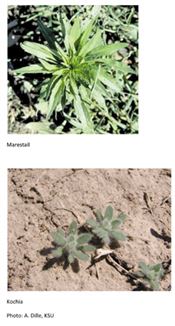|
USCP Agronomy Check
BRENT BEAN
LUBBOCK, TEXAS
Pre-plant weed control is critical for all crops, but the practice is especially essential for grain sorghum. With corn, soybeans and cotton, planting herbicide-tolerant varieties and using post-emergence herbicides often can resolve weed issues. But grain sorghum does not have this luxury. Winter and spring weeds rob the soil of moisture, which is invaluable to the success of dryland crops. In sorghum, 1 inch of stored soil moisture can be worth 600 pounds or more of grain production. Although there are several winter and spring weeds of importance for sorghum, two of the more troublesome weeds are kochia and marestail.

Kochia emerges as one of the first annual weeds in the late winter or early spring and can germinate at soil temperatures just above freezing. Research shows that kochia germination can be as high as 92 percent when soil temperatures reach 40 degrees.
Marestail has become an annual weed issue in many production systems. The weed can germinate over several months and first appears in a field in its rosette stage. While in the rosette stage, marestail is fairly easy to control. However, control is much more difficult to achieve once it “bolts.” If a grower can see marestail from the road, achieving control will be much more difficult and expensive.
Historically, glyphosate has been used to control both of these weeds, but unfortunately kochia and marestail have become resistant to glyphosate in many areas. If glyphosate is used, it should be mixed with other effective herbicides. Two of the more effective products are dicamba (Banvel, Clarity) and atrazine. Starane and 2,4-D may be considered in addition to or as a substitute for dicamba, particularly for kochia control. Adding atrazine to any mix is important to provide residual control of kochia and marestail, as well as other weeds. Sharpen (saflufenacil), an excellent burndown product with some residual activity, also should be considered for controlling these weeds. A rate of 1-2 ounces per acre of Sharpen added to a glyphosate mix has been shown to significantly improve the control of both kochia and marestail.
Regardless of which herbicides are used, growers are strongly encouraged to use multiple mode-of-action herbicides to achieve better control and avoid the development of resistance. In addition, control will be much more successful on small, actively growing weeds. Weed control failures are reported most often when weeds are large or suffering from drought stress at the time of herbicide application.
Be sure to follow any sorghum planting restrictions on the herbicide labels. In general, sorghum can be planted immediately following atrazine, 2,4-D or Starane application. With dicamba, sorghum planting should be delayed a minimum of 15 days. The Sharpen label allows for immediate planting of sorghum when 2 ounces or less are used. If planting is anticipated within seven days, many agronomists suggest using the 1-ounce rate. ∆
BRENT BEAN: USCP Agronomist

|
|